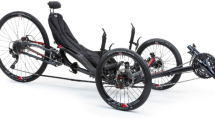Abstract
The safety and the fatigue comfort were compared between a domestic and a Japanese postal bicycle. Firstly, the fatigue comfort of these two kinds of bicycles was evaluated by surface electromyographic signal (sEMG) experiment, in which human lower limb muscle groups were research objects, and the average EMG (AEMG) index and median frequency (MF) were chosen as the evaluation indexes. Secondly, the safety of these two kinds of bicycle frames was analyzed and compared by using the finite element analysis. The results show that the riding fatigue comfort of the Japanese postal bicycle is better, and the Japanese postal bicycle frame is more safe and reasonable although both the postal bicycles meet the requirement for strength. Finally, based on the above analysis, the frame structure and related parameters of the domestic postal bicycle were improved with reference to the Japanese postal bicycle and biomechanics theory.
Similar content being viewed by others
References
Qingdao Post Office Delivery Department. The present situation Global postal bicycle development[J]. The UPU, 2010(4): 6 (in Chinese).
Ferraresi C, Garibaldi L, Perocchio D et al. Dynamic behavior and optimization of frames for road and mountain bikes[C]. In: The 16th International Modal Analysis Conference. Santa Barbara, CA, USA, 1998. 387–393.
Champoux Y, Vittecoq P, Maltais P et al. Measuring the dynamic structural load of an off-road bicycle frame[J]. Experimental Techniques, 2004, 28(3): 33–36.
Xu Wen. The Bicycle Design Method Research and Application Considering the Posture[D]. School of Mechanical Engineering, Tianjin University, 2007 (in Chinese).
Liu Han. The Riding Dynamic Performance Analysis of Mountain Bike[D]. School of Mechanical Engineering, Tianjin University, 2007 (in Chinese).
Bu Yan, Xiang Zhongxia, Huang Tian et al. Optimal design and dynamic simulation of mountain bike with rear suspension[J]. Chinese Journal of Mechanical Engineering (English Edition), 2009, 22(1): 21–26.
Xiang Zhongxia, Xu Ruifen, Bu Yan et al. Optimal design of bicycle frame parameters considering biomechanics[J]. Chinese Journal of Mechanical Engineering (English Edition), 2011, 24(1): 141–145.
Sanderson D J, Amoroso A T. The influence of seat height on the mechanical function of the triceps surae muscles during steady-rate cycling[J]. Journal of Electromyography and Kinesiology, 2009, 19(6): 465–471.
Huang Yong, Wang Lejun, Gong Mingxin et al. The sEMG characteristics of lower limb muscles and the relevancy of output power in cyclist[J]. Journal of Shanghai Physical Education Institute, 2010, 34(5): 64–67 (in Chinese).
Disselhorst-Klug Catherine, Schmitz-Rode Thomas, Rau Gunter. Surface electromyography and muscle force: Limits in sEMG-force relationship and new approaches for applications[J]. Clinical Biomechanics, 2009, 24(3): 225–235.
Sbriccoli P, Bazzucchi I, Rosponi A et a1. Amplitude and spectral characteristics of biceps Brachii sEMG depend upon speed of isometric force generation[J]. Journal of Electromyography and Kinesiology, 2003, 13(2): 139–147.
Bu Yan, Huang Tian, Xiang Zhongxia et al. Optimal design of mountain bicycle based on biomechanics[J]. Transactions of Tianjin University, 2010, 16(1): 45–49.
Xiang Zhongxia, Tian Guan, Xu Wen et al. Load on bicycle frame during cycling with different speeds and gestures[ J]. Transactions of Tianjin University, 2011, 17(4): 270–274.
ISO 630-1995. Structural Steels: Plates, Wide Flats, Bars, Sections and Profiles, NEQ[S]. 2006.
Wang Shibin, Kang Yilan, Wang Yanqun. Material Mechanics[M]. Higher Education Press, Beijing, China, 2008 (in Chinese).
Author information
Authors and Affiliations
Corresponding author
Additional information
Supported by Special Fund Project for Technology Innovation of Tianjin (No.10FDZDGX00500) and Tianjin Product Quality Inspection Technology Research Institute.
Xiang Zhongxia, born in 1964, female, Dr, Prof.
Rights and permissions
About this article
Cite this article
Xiang, Z., Li, Y., Tian, G. et al. Analysis and comparison of safety and fatigue comfort of postal bicycles based on finite element method and sEMG. Trans. Tianjin Univ. 19, 272–278 (2013). https://doi.org/10.1007/s12209-013-1975-y
Accepted:
Published:
Issue Date:
DOI: https://doi.org/10.1007/s12209-013-1975-y




